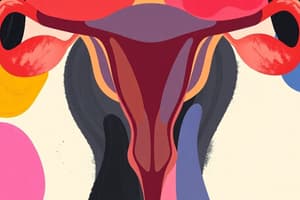Podcast
Questions and Answers
True or false: Sperm can survive for up to five days in the male reproductive system?
True or false: Sperm can survive for up to five days in the male reproductive system?
True (A)
True or false: Seminal fluid makes up 60% of sperm?
True or false: Seminal fluid makes up 60% of sperm?
False (B)
True or false: The Cowper’s Gland adds a thick and slippery fluid to the penis for lubrication during intercourse?
True or false: The Cowper’s Gland adds a thick and slippery fluid to the penis for lubrication during intercourse?
True (A)
True or false: Oestrogen and progesterone are hormones produced by the ovaries from puberty until menopause?
True or false: Oestrogen and progesterone are hormones produced by the ovaries from puberty until menopause?
True or false: Fallopian tubes are lined with cilia that beat in unison to waft the egg towards the uterus?
True or false: Fallopian tubes are lined with cilia that beat in unison to waft the egg towards the uterus?
Progesterone inhibits both FSH and LH, and thickens the endometrium
Progesterone inhibits both FSH and LH, and thickens the endometrium
The fertilization of the egg by sperm takes place in the fallopian tube
The fertilization of the egg by sperm takes place in the fallopian tube
In vitro fertilization involves fertilizing the eggs outside the womb in a petri dish
In vitro fertilization involves fertilizing the eggs outside the womb in a petri dish
Low testosterone levels in males due to endocrine gland failure can be overcome using hormone replacement therapy with testosterone
Low testosterone levels in males due to endocrine gland failure can be overcome using hormone replacement therapy with testosterone
The amnion is a sac that forms around the embryo and is filled with amniotic fluid by the fourth week of pregnancy
The amnion is a sac that forms around the embryo and is filled with amniotic fluid by the fourth week of pregnancy
During birth, the amniotic sac bursts and passes out through the vagina before the cervix dilates to 10 cm wide
During birth, the amniotic sac bursts and passes out through the vagina before the cervix dilates to 10 cm wide
Breast milk produced at the start of lactation is yellow in color and rich in nutrients and antibodies
Breast milk produced at the start of lactation is yellow in color and rich in nutrients and antibodies
The contraceptive pill contains progesterone and estrogen which prevent ovulation
The contraceptive pill contains progesterone and estrogen which prevent ovulation
The withdrawal method is 100% effective at preventing pregnancy
The withdrawal method is 100% effective at preventing pregnancy
The intrauterine device (IUD) is inserted into the uterus and prevents fertilization and implantation
The intrauterine device (IUD) is inserted into the uterus and prevents fertilization and implantation
True or false: Fertilization occurs in the top third of the fallopian tube
True or false: Fertilization occurs in the top third of the fallopian tube
True or false: The cervix is blocked by a mucus plug for most of the month, but thins out around ovulation to allow sperm to enter the uterus
True or false: The cervix is blocked by a mucus plug for most of the month, but thins out around ovulation to allow sperm to enter the uterus
True or false: The vagina is lubricated with acidic mucus to prevent the growth of pathogenic microorganisms
True or false: The vagina is lubricated with acidic mucus to prevent the growth of pathogenic microorganisms
True or false: After puberty, approximately 20 eggs are produced by meiosis each month
True or false: After puberty, approximately 20 eggs are produced by meiosis each month
True or false: The fertile period for fertilization is days 9 to 15 of the menstrual cycle
True or false: The fertile period for fertilization is days 9 to 15 of the menstrual cycle
Study Notes
Human Reproductive System Overview
- Fertilization occurs in the top third of the fallopian tube
- Menstruation lasts for 3-7 days, with a typical fluid loss of 30-90 ml
- The cervix is blocked by a mucus plug for most of the month, but thins out around ovulation to allow sperm to enter the uterus
- The vagina is lubricated with acidic mucus to prevent the growth of pathogenic microorganisms
- Sperm has a head containing the haploid nucleus, a midpiece with mitochondria, and a tail for propulsion
- After puberty, approximately 20 eggs are produced by meiosis each month
- Primary sexual characteristics are directly involved with reproduction, while secondary sexual characteristics develop at puberty
- Testosterone is the main hormone in males, while estrogen is the main hormone in females
- The menstrual cycle starts at puberty and ends at menopause, typically between the late forties and early fifties
- The menstrual cycle involves changes in the ovaries and uterus, making pregnancy possible
- The fertile period for fertilization is days 9 to 15 of the menstrual cycle
- Hormones such as FSH, LH, estrogen, and progesterone play crucial roles in the menstrual cycle and fertility
Studying That Suits You
Use AI to generate personalized quizzes and flashcards to suit your learning preferences.
Related Documents
Description
Test your knowledge of the human reproductive system with this overview quiz. Explore the menstrual cycle, fertilization, hormone roles, and reproductive anatomy. Brush up on key concepts and terminology related to human reproduction.




